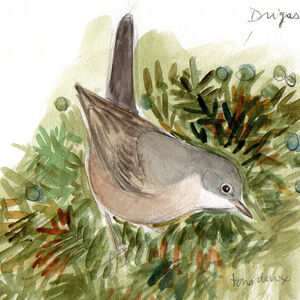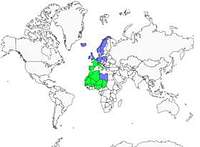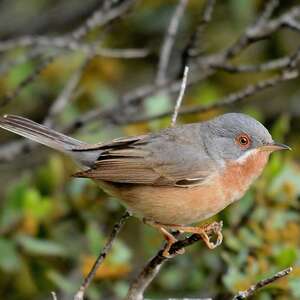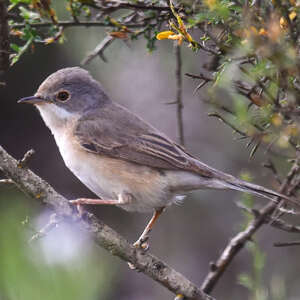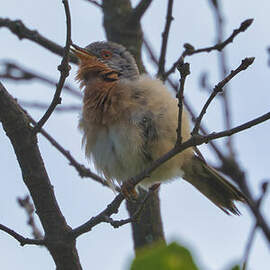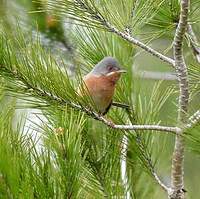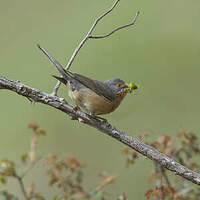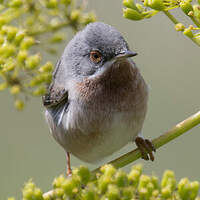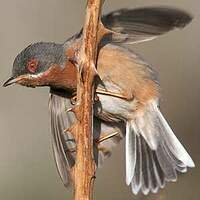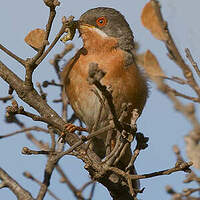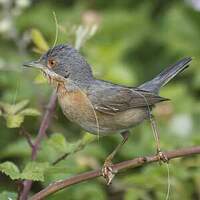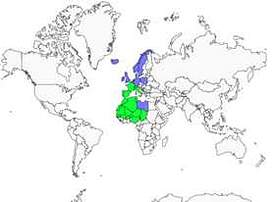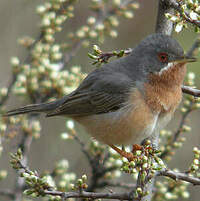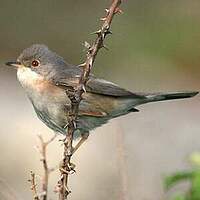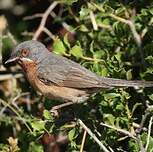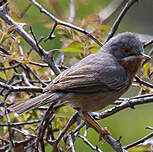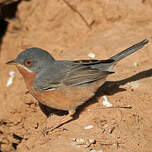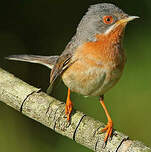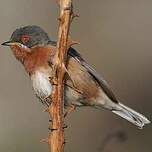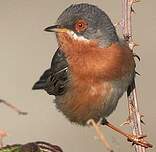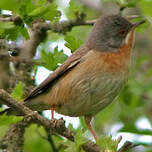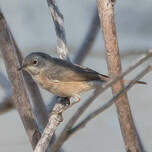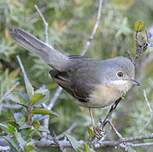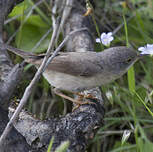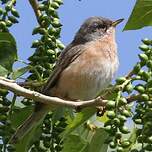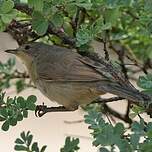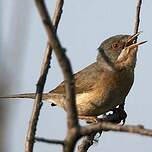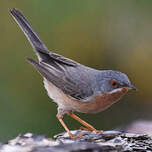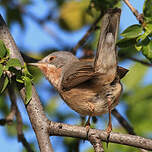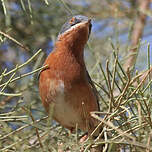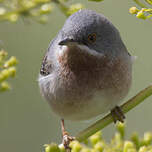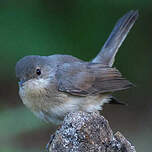Western Subalpine Warbler
Curruca iberiae - Fauvette passerinette
Identification
By its shape and appearance, it looks like a small, thinner Grey Wagtail with a relatively shorter tail. Under good lighting, the male shows a head and back that is blue-grey, similar to that of a Siskin. The back is tinged with brown, the sides of the head a bit darker. The slender white moustache running down either side of the beak makes the brick red or wine pink of the throat particularly stand out. The bright colour of the throat changes to brown on the chest and sides. The belly is white, the undertail coverts reddish-brown, edged with white. The remiges are a dark greyish-brown with pale edges. The rectrices are similar but with grey edges. The outer rectrices are almost entirely white, the next three with a white tip. At close range, a red ring can be seen around the eye.
The adult female and young are usually duller. The upper parts are washed with brown, the throat whitish, the moustaches scarcely projecting and the underparts tending towards yellowish. The remiges are darker with paler, less pure and less extensive white edging. The colour of the underparts can vary from vivid to pale, from red to pinkish-fawn and wine-purple, even in the females. In the autumn, juvéniles with scarcely visible moustaches can pose identification problems and be mistaken for Grey Wagtails, Northern Hill Wablers and even Common Chiffchaffs.
Subspecific information monotypic species
Foreign names
- Fauvette passerinette,
- Curruca carrasqueña occidental,
- toutinegra-de-bigodes,
- Iberien-Bartgrasmücke,
- Westelijke Baardgrasmus,
- rostsångare,
- penica bielofúza,
- pěnice západní,
- Iberisk Sanger,
- pokrzewka iberyjska,
- 西亚高山林莺,
- rostsångare,
Voice song and call
The song of the Western Subalpine Warbler is similar to that of the Grey Wagtail. It is delivered quickly and without striking features. Hard or harsh notes are absent and there is no variance in tone. The performances vary depending on the individual. Sometimes the bird strings together pure notes, melodious and fluted motifs, and other times it expresses itself in a incoherent and confused manner, stammering like a Moorhen with slightly grating sounds. If we do not consider the sound quality and focus only on the musicality of the song, then we can consider the Western Subalpine Warbler to be the best artist among the Southern warblers. In terms of its call, its presence is betrayed by its thin tec-tec or tac-tac sounds interspersed with a brief silence. It also emits tectectectectectec series quickly to mark its concern. We also hear zizizizizi....chchchch, sort of buzzy rustling that would indicate its irritation.
Habitat
The Western Subalpine Warbler's name, which is also given to this species, suits it perfectly. Indeed, outside of the periods when it passes through and is the only time it is found in the lower plains, this bird prefers to settle in garrigues, on the sides of hills and even in mountains.
Behaviour character trait
To look for food, the Western Subalpine Warbler explores the lower shrubs of its rather limited territory, but it prefers even more the crowns of deciduous trees, even though they are located at quite a distance from its properties.
It is used to fluttering its wings and vertically lifting its tail. For the back, it accomplishes a direct flight for a rather long period of time, at a height of several meters. Aside from these few displacements, it tends to adopt a behavior similar to that of the tit, displaying some timidness and hiding within the foliage. The passerinettes of the south of France are exclusively migratory. They leave in September-October and choose their winter quarters in the southern border of the Sahara, from Senegal to Chad. In spring, the first birds appear in the end of March in Provence. However, the greatest part of the migrants only come back in April and even later. The passages over the Sahara are carried out until the middle of May.Flight
The Western Subalpine Warblers produce a light, swift, and assured flight that is reminiscent of the Grey Wagtail's flight but with faster wing beats. The escape flight is short, quickly sinking down into the closest undergrowth.
Dietfeeding habits
Reproduction nesting
During the mating display, the male jumps around the female while vibrating his wings and deploying his tail vertically to reveal the white underside.
At the end of March, the female starts building the nest. The male accompanies her by chirping a few notes. The nest is a simple cup placed between two twigs in a low shrub at a low height (between 15 and 90 cm). It is a well-made, quite thick and deep structure, the main body of which is made of dry rods and strands of grass. The inside is lined with fine fibers, down and hair. The clutch consists of 3 or 4 eggs which the female incubates for 11 to 12 days alone. The stay at the nest is identical. Both parents feed the chicks and perfectly conceal their comings and goings.Geographic range
The Western Subalpine Warbler has a south-Europe and Mediterranean distribution. The type subspecies, Sylvia cantillans, nests in the Iberian Peninsula, in Southwest France, in Sicily and in Central and Southern Italy. The subspecies subalpina nests in Corsica, Sardinia, the Balearic Islands as well as in the north and center of the continental Italy. The subspecies albistriata inhabits the Adriatic coasts of the former Yugoslavia, Macedonia, Greece, Anatolia and Syria. It also occupies the extreme north of the Italian coast. The subspecies inornata lives in the center and north of Morocco, north of Algeria and Tunisia as well as in the extreme south of Spain. The Western Subalpine Warbler winterssouth of the Sahara, occupying a wide band that stretches from the south of Mauritania and Senegal to the north of Sudan.
Threats - protection
Sources of information
- IOC World Bird List (v15.1), Gill, F and D Donsker (Eds). 2025-12-07.
Other sources of interest
 Specification sheet created on
28/10/2023 by Alexandre Knochel with help of Georges Olioso and Daniel Le-Dantec
Specification sheet created on
28/10/2023 by Alexandre Knochel with help of Georges Olioso and Daniel Le-DantecTranslation by AI Oiseaux.net
© 1996-2025 Oiseaux.net
- Accipitriformes
- Aegotheliformes
- Anseriformes
- Apodiformes
- Apterygiformes
- Bucerotiformes
- Caprimulgiformes
- Cariamiformes
- Casuariiformes
- Charadriiformes
- Ciconiiformes
- Coliiformes
- Columbiformes
- Coraciiformes
- Cuculiformes
- Eurypygiformes
- Falconiformes
- Galliformes
- Gaviiformes
- Gruiformes
- Leptosomiformes
- Mesitornithiformes
- Musophagiformes
- Nyctibiiformes
- Opisthocomiformes
- Otidiformes
- Passeriformes
- Pelecaniformes
- Phaethontiformes
- Phoenicopteriformes
- Piciformes
- Podargiformes
- Podicipediformes
- Procellariiformes
- Psittaciformes
- Pterocliformes
- Rheiformes
- Sphenisciformes
- Steatornithiformes
- Strigiformes
- Struthioniformes
- Suliformes
- Tinamiformes
- Trogoniformes

